Bayesian Fusion Model Enhanced Codfish Classification Using Near Infrared and Raman Spectrum
Abstract
:1. Introduction
2. Materials and Methods
2.1. Codfish Samples Preparation
2.2. Spectrometer and Spectral Data Acquisition
2.2.1. Near Infrared Spectrometer
2.2.2. Raman Spectrometer
2.3. Data Processing and Multivariate Analysis
2.3.1. Spectrum Preprocessing
2.3.2. Selection of Important Wavenumbers
2.3.3. Development of Classification Models
2.3.4. Bayes Information Fusion Method
2.4. Model Performance Evaluation
3. Results and Discussion
3.1. Analysis of NIRS Modeling Results
3.1.1. Analysis of the NIRS Features
3.1.2. Selection of Pretreatment Methods for NIRS
3.1.3. Extraction of Effective Wavenumbers
3.1.4. Modeling Based on Selected Optimal Wavenumbers
3.2. Analysis of RS Modeling Results
3.2.1. Analysis of the Spectral Features
3.2.2. Selection of Pretreatment Methods for RS
3.2.3. Extraction of Effective Wavenumbers
3.2.4. Modeling Based on Optimal Wavenumbers
3.3. Analysis of Bayesian Fusion Data Results
4. Conclusions
Author Contributions
Funding
Institutional Review Board Statement
Data Availability Statement
Conflicts of Interest
Abbreviations
References
- Fernandes, T.J.R.; Amaral, J.S.; Mafra, I. DNA barcode markers applied to seafood authentication: An updated review. Crit. Rev. Food Sci. Nutr. 2020, 61, 3904–3935. [Google Scholar] [CrossRef]
- Anjali, K.M.; Mandal, A.; Gunalan, B.; Ruban, L.; Anandajothi, E.; Thineshsanthar, D.; Manojkumar, T.G.; Kandan, S. Identification of six grouper species under the genus Epinephelus (Bloch, 1793) from Indian waters using PCR-RFLP of cytochrome c oxidase I (COI) gene fragment. Food Control 2019, 101, 39–44. [Google Scholar] [CrossRef]
- Delpiani, G.; Delpiani, S.M.; Antoni, M.Y.D.; Ale, M.C.; Fischer, L.; Lucifora, L.O.; de Astarloa, J.M.D. Are we sure we eat what we buy? Fish mislabelling in Buenos Aires province, the largest sea food market in Argentina. Fish. Res. 2020, 221, 105373. [Google Scholar] [CrossRef]
- Willette, D.A.; Cheng, S.H. Delivering on seafood traceability under the new U.S. import monitoring program. Ambio 2018, 47, 25–30. [Google Scholar] [CrossRef]
- Xiong, X.; Yuan, F.Y.; Huang, M.H.; Cao, M.; Xiong, X.H. Development of a rapid method for codfish identification in processed fish products based on SYBR Green real-time PCR. Int. J. Food Sci. Technol. 2020, 55, 1843–1850. [Google Scholar] [CrossRef]
- Taboada, L.; Sanchez, A.; Perez-Martin, R.I.; Sotelo, C.G. A new method for the rapid detection of Atlantic cod (Gadus morhua), Pacific cod (Gadus macrocephalus), Alaska pollock (Gadus chalcogrammus) and ling (Molva molva) using a lateral flow dipstick assay. Food Chem. 2017, 233, 182–189. [Google Scholar] [CrossRef] [PubMed]
- Miller, D.; Jessel, A.; Mariani, S. Seafood mislabelling: Comparisons of two western European case studies assist in defining influencing factors, mechanisms and motives. Fish Fish. 2012, 13, 345–358. [Google Scholar] [CrossRef]
- Kotsanopoulos, K.V.; Exadactylos, A.; Gkafas, G.A.; Martsikalis, P.V.; Parlapani, F.F.; Boziaris, I.S.; Arvanitoyannis, I.S. The use of molecular markers in the verification of fish and seafood authenticity and the detection of adulteration. Compr. Rev. Food Sci. Food Saf. 2021, 20, 1584–1654. [Google Scholar] [CrossRef]
- Wang, C.Y.; Bi, H.Y. Super-fast seafood authenticity analysis by One-step pretreatment and comparison of mass spectral patterns. Food Control 2021, 123, 107751. [Google Scholar] [CrossRef]
- Fiorino, G.M.; Fresch, M.; Brummer, I.; Losito, I.; Arlorio, M.; Brockmeyer, J.; Monaci, L. Mass Spectrometry-Based Untargeted Proteomics for the Assessment of Food Authenticity: The Case of Farmed versus Wild-Type Salmon. J. AOAC Int. 2019, 102, 1339–1345. [Google Scholar] [CrossRef]
- Velasco, A.; Ramilo-Fernandez, G.; Sotelo, C.G. A Real-Time PCR Method for the Authentication of Common Cuttlefish (Sepia officinalis) in Food Products. Foods 2020, 9, 286. [Google Scholar] [CrossRef] [PubMed] [Green Version]
- Wang, C.Y.; Bi, H.Y.; Xie, J. Visualization of the Distance among Fishes by MALDI MS for Rapid Determination of the Taxonomic Status of Fish Fillets. J. Agric. Food Chem. 2020, 68, 8438–8446. [Google Scholar] [CrossRef] [PubMed]
- Currò, S.; Fasolato, L.; Serva, L.; Boffo, L.; Ferlito, J.C.; Novelli, E.; Balzan, S. Use of a portable near-infrared tool for rapid on-site inspection of freezing and hydrogen peroxide treatment of cuttlefish (Sepia officinalis). Food Control 2022, 132, 108524. [Google Scholar] [CrossRef]
- Benson, I.M.; Barnett, B.K.; Helser, T.E. Classification of fish species from different ecosystems using the near infrared diffuse reflectance spectra of otoliths. J. Near Infrared Spectrosc. 2020, 28, 224–235. [Google Scholar] [CrossRef]
- Wu, T.; Zhong, N.; Yang, L. Application of VIS/NIR Spectroscopy and SDAE-NN Algorithm for Predicting the Cold Storage Time of Salmon. J. Spectrosc. 2018, 2018, 7450695. [Google Scholar] [CrossRef] [Green Version]
- Rašković, B.; Heinke, R.; Rösch, P.; Popp, J. The Potential of Raman Spectroscopy for the Classification of Fish Fillets. Food Anal. Methods 2015, 9, 1301–1306. [Google Scholar] [CrossRef]
- Power, A.; Cozzolino, D. How Fishy Is Your Fish? Authentication, Provenance and Traceability in Fish and Seafood by Means of Vibrational Spectroscopy. Appl. Sci. 2020, 10, 4150. [Google Scholar] [CrossRef]
- Osorio, M.T.; Haughey, S.A.; Elliott, C.T.; Koidis, A. Identification of vegetable oil botanical speciation in refined vegetable oil blends using an innovative combination of chromatographic and spectroscopic techniques. Food Chem. 2015, 189, 67–73. [Google Scholar] [CrossRef] [Green Version]
- Yu, H.D.; Qing, L.W.; Yan, D.T.; Xia, G.; Zhang, C.; Yun, Y.H.; Zhang, W. Hyperspectral imaging in combination with data fusion for rapid evaluation of tilapia fillet freshness. Food Chem. 2021, 348, 129129. [Google Scholar] [CrossRef]
- Mishra, P.; Nordon, A.; Mohd Asaari, M.S.; Lian, G.; Redfern, S. Fusing spectral and textural information in near-infrared hyperspectral imaging to improve green tea classification modelling. J. Food Eng. 2019, 249, 40–47. [Google Scholar] [CrossRef]
- Yang, C.; Guang, P.; Li, L.; Song, H.; Huang, F.; Li, Y.; Wang, L.; Hu, J. Early rapid diagnosis of Alzheimer’s disease based on fusion of near- and mid-infrared spectral features combined with PLS-DA. Optik 2021, 241, 166485. [Google Scholar] [CrossRef]
- Syvilay, D.; Wilkie-Chancellier, N.; Trichereau, B.; Texier, A.; Martinez, L.; Serfaty, S.; Detalle, V. Evaluation of the standard normal variate method for Laser-Induced Breakdown Spectroscopy data treatment applied to the discrimination of painting layers. Spectrochim. Acta Part B Atom. Spectrosc. 2015, 114, 38–45. [Google Scholar] [CrossRef]
- Debebe, A.; Temesgen, S.; Abshiro, M.R.; Chandravanshi, B.S. Partial least squares—Near infrared spectrometric determination of ethanol in distilled alcoholic beverages. Bull. Chem. Soc. Ethiop. 2017, 31, 201. [Google Scholar] [CrossRef] [Green Version]
- Sabatier, D.; Dardenne, P.; Thuriès, L. Near Infrared Reflectance Calibration Optimisation to Predict Lignocellulosic Compounds in Sugarcane Samples with Coarse Particle Size. J. Near Infrared Spectrosc. 2011, 19, 199–209. [Google Scholar] [CrossRef]
- He, X.; Wang, J.; Gao, C.; Liu, Y.; Li, Z.; Li, N.; Xia, J. Differentiation of white architectural paints by microscopic laser Raman spectroscopy and chemometrics. Spectrochim. Acta A Mol. Biomol. Spectrosc. 2021, 248, 119284. [Google Scholar] [CrossRef]
- Ma, J.; Cheng, J.-H.; Sun, D.-W.; Liu, D. Mapping changes in sarcoplasmatic and myofibrillar proteins in boiled pork using hyperspectral imaging with spectral processing methods. LWT 2019, 110, 338–345. [Google Scholar] [CrossRef]
- Liu, D.; Sun, D.-W.; Zeng, X.-A. Recent Advances in Wavelength Selection Techniques for Hyperspectral Image Processing in the Food Industry. Food Bioprocess Technol. 2013, 7, 307–323. [Google Scholar] [CrossRef]
- Yun, Y.H.; Wang, W.T.; Tan, M.L.; Liang, Y.Z.; Li, H.D.; Cao, D.S.; Lu, H.M.; Xu, Q.S. A strategy that iteratively retains informative variables for selecting optimal variable subset in multivariate calibration. Anal. Chim. Acta 2014, 807, 36–43. [Google Scholar] [CrossRef]
- Li, H.; Liang, Y.; Xu, Q.; Cao, D. Key wavelengths screening using competitive adaptive reweighted sampling method for multivariate calibration. Anal. Chim. Acta 2009, 648, 77–84. [Google Scholar] [CrossRef]
- Wu, D.; Nie, P.; He, Y.; Wang, Z.; Wu, H. Spectral Multivariable Selection and Calibration in Visible-Shortwave Near-Infrared Spectroscopy for Non-Destructive Protein Assessment of Spirulina Microalga Powder. Int. J. Food Prop. 2013, 16, 1002–1015. [Google Scholar] [CrossRef]
- Amirvaresi, A.; Nikounezhad, N.; Amirahmadi, M.; Daraei, B.; Parastar, H. Comparison of near-infrared (NIR) and mid-infrared (MIR) spectroscopy based on chemometrics for saffron authentication and adulteration detection. Food Chem. 2021, 344, 128647. [Google Scholar] [CrossRef] [PubMed]
- Wang, H.Q.; Song, W.; Tao, W.W.; Zhang, J.H.; Zhang, X.; Zhao, J.J.; Yong, J.J.; Gao, X.J.; Guo, L.P. Identification wild and cultivated licorice by multidimensional analysis. Food Chem. 2021, 339, 128111. [Google Scholar] [CrossRef] [PubMed]
- Sweger, S.R.; Pribitzer, S.; Stoll, S. Bayesian Probabilistic Analysis of DEER Spectroscopy Data Using Parametric Distance Distribution Models. J. Phys. Chem. A 2020, 124, 6193–6202. [Google Scholar] [CrossRef] [PubMed]
- Fearn, T.; Perez-Marin, D.; Garrido-Varo, A.; Guerrero-Ginel, J.E. Classifying with confidence using Bayes rule and kernel density estimation. Chemometr. Intell. Lab. Syst. 2019, 189, 81–87. [Google Scholar] [CrossRef]
- Raji, C.A.; Willeumier, K.; Taylor, D.; Tarzwell, R.; Newberg, A.; Henderson, T.A.; Amen, D.G. Functional neuroimaging with default mode network regions distinguishes PTSD from TBI in a military veteran population. Brain Imaging Behav. 2015, 9, 527–534. [Google Scholar] [CrossRef] [Green Version]
- Fan, N.; Ma, X.; Liu, G.; Ban, J.; Yuan, R.; Sun, Y. Rapid determination of TBARS content by hyperspectral imaging for evaluating lipid oxidation in mutton. J. Food Compos. Anal. 2021, 103, 104110. [Google Scholar] [CrossRef]
- Grassi, S.; Casiraghi, E.; Alamprese, C. Handheld NIR device: A non-targeted approach to assess authenticity of fish fillets and patties. Food Chem. 2018, 243, 382–388. [Google Scholar] [CrossRef]
- Kimiya, T.; Sivertsen, A.H.; Heia, K. VIS/NIR spectroscopy for non-destructive freshness assessment of Atlantic salmon (Salmo salar L.) fillets. J. Food Eng. 2013, 116, 758–764. [Google Scholar] [CrossRef]
- Afkhami, A.; Bahram, M. Mean centering of ratio spectra as a new spectrophotometric method for the analysis of binary and ternary mixtures. Talanta 2005, 66, 712–720. [Google Scholar] [CrossRef]
- Herrero, A.M. Raman spectroscopy a promising technique for quality assessment of meat and fish: A review. Food Chem. 2008, 107, 1642–1651. [Google Scholar] [CrossRef]
- Sun, W.; Zhao, Q.; Zhao, M.; Yang, B.; Cui, C.; Ren, J. Structural evaluation of myofibrillar proteins during processing of Cantonese sausage by Raman spectroscopy. J. Agric. Food Chem. 2011, 59, 11070–11077. [Google Scholar] [CrossRef] [PubMed]
- Zhang, T.; Li, Z.; Wang, Y.; Xue, Y.; Xue, C. Effects of konjac glucomannan on heat-induced changes of physicochemical and structural properties of surimi gels. Food Res. Int. 2016, 83, 152–161. [Google Scholar] [CrossRef]
- Yang, G.; Dai, J.; Liu, X.; Chen, M.; Wu, X. Multiple Constrained Reweighted Penalized Least Squares for Spectral Baseline Correction. Appl. Spectrosc. 2020, 74, 1443–1451. [Google Scholar] [CrossRef] [PubMed]
- Sarkar, P.; Bickel, P.J. Role of normalization in spectral clustering for stochastic blockmodels. Ann. Stat. 2015, 43, 962–990. [Google Scholar] [CrossRef]
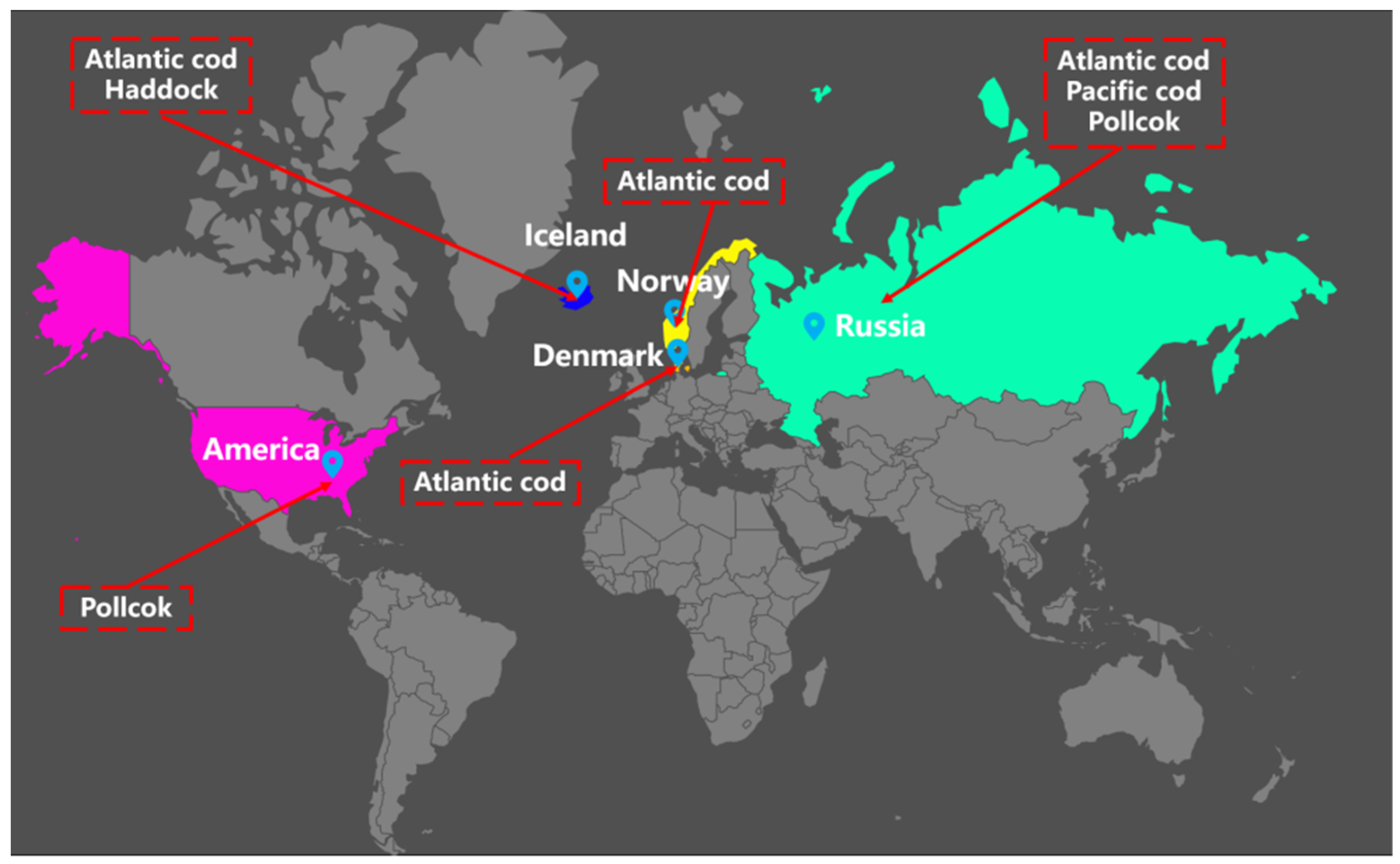
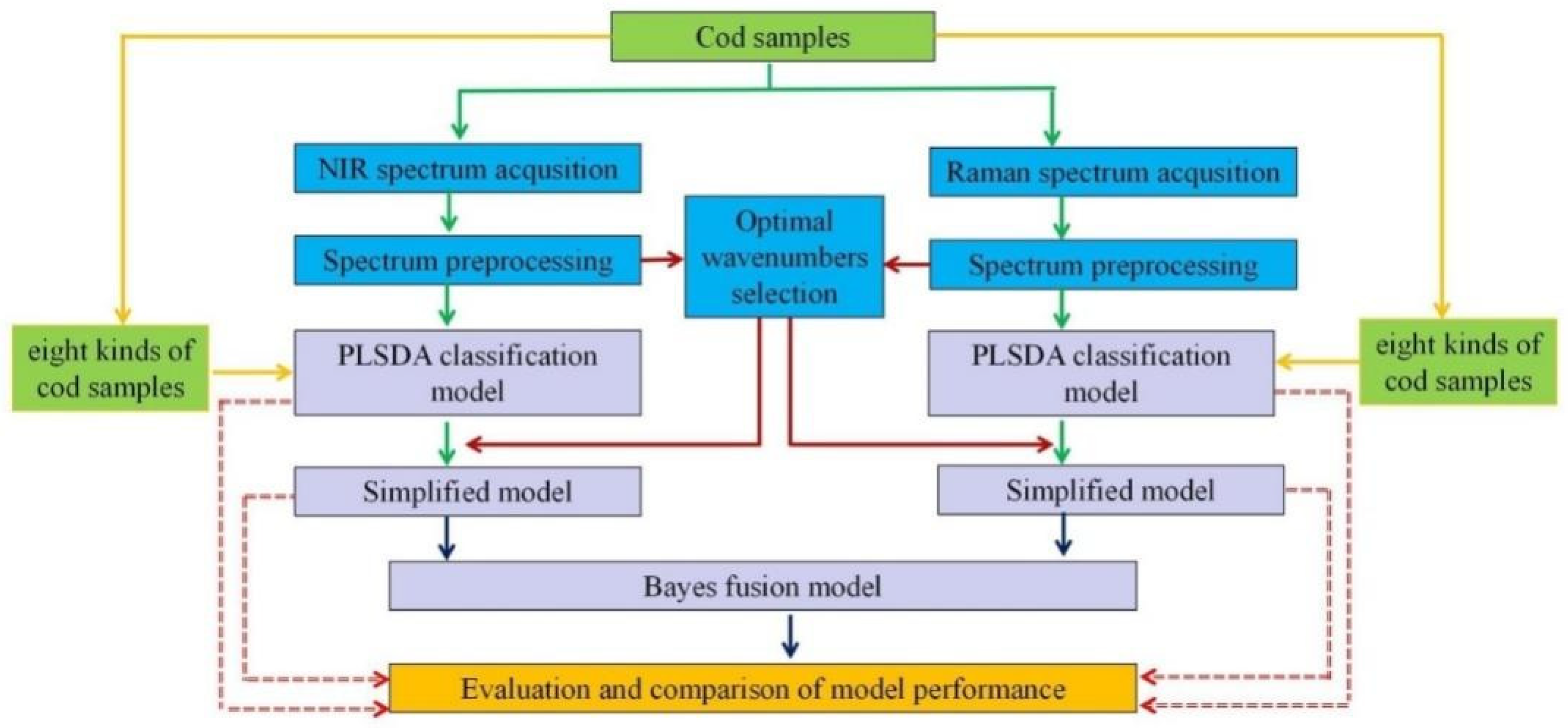
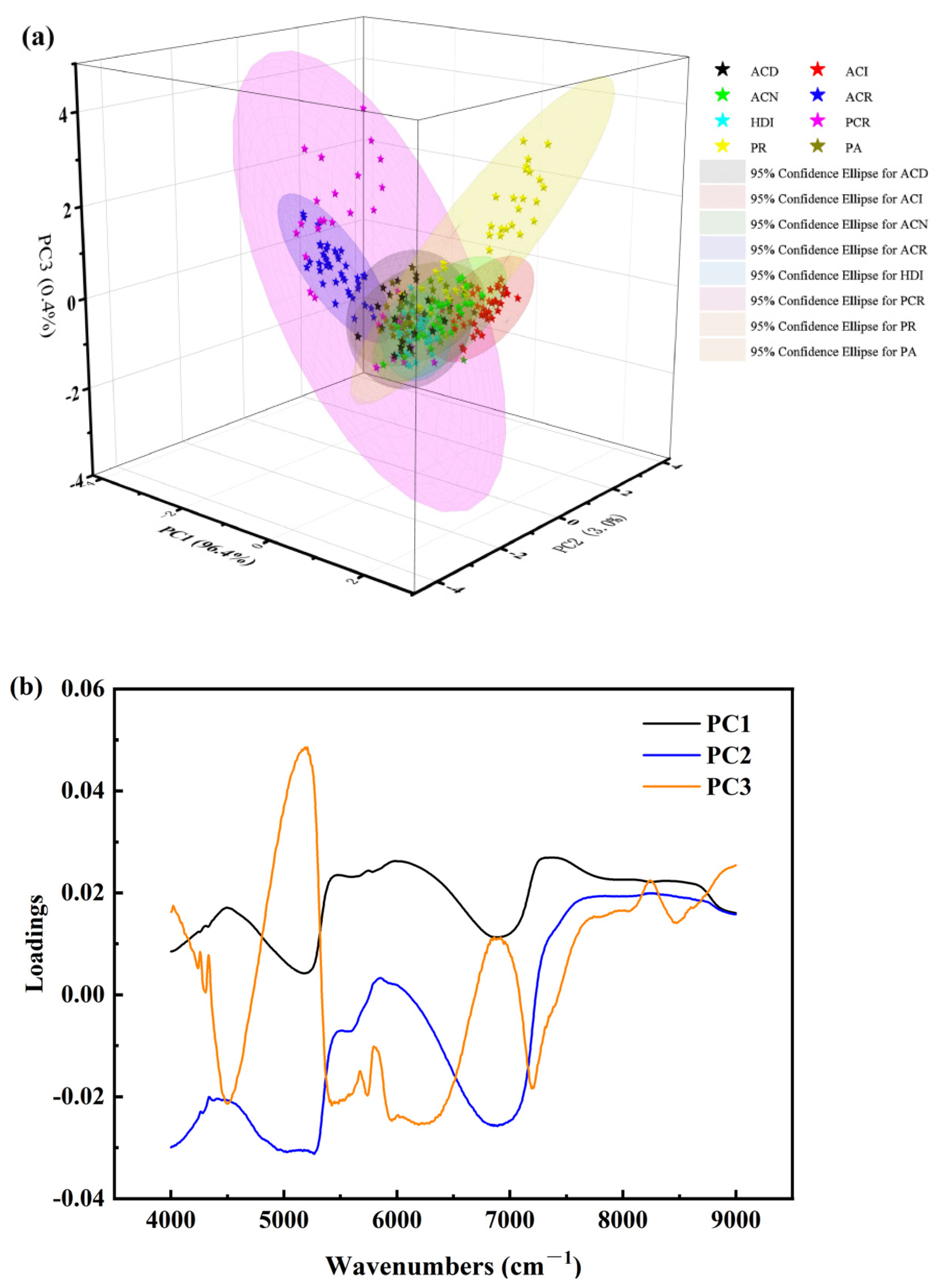
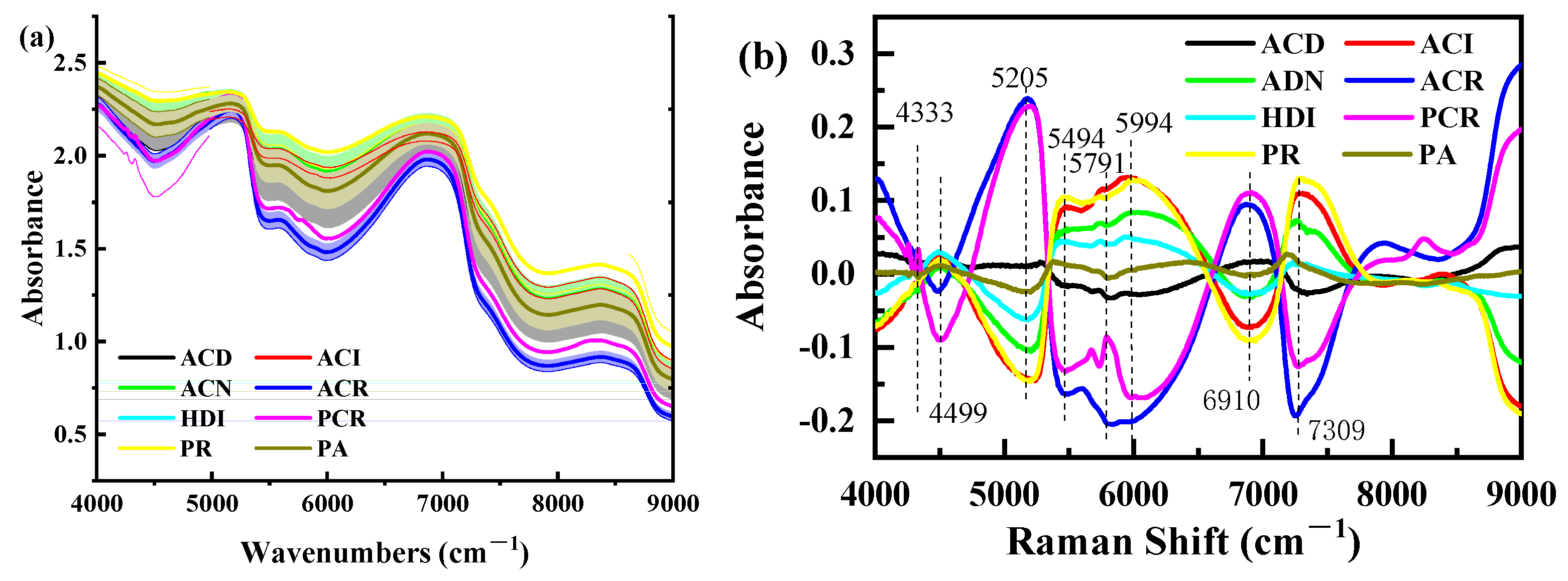
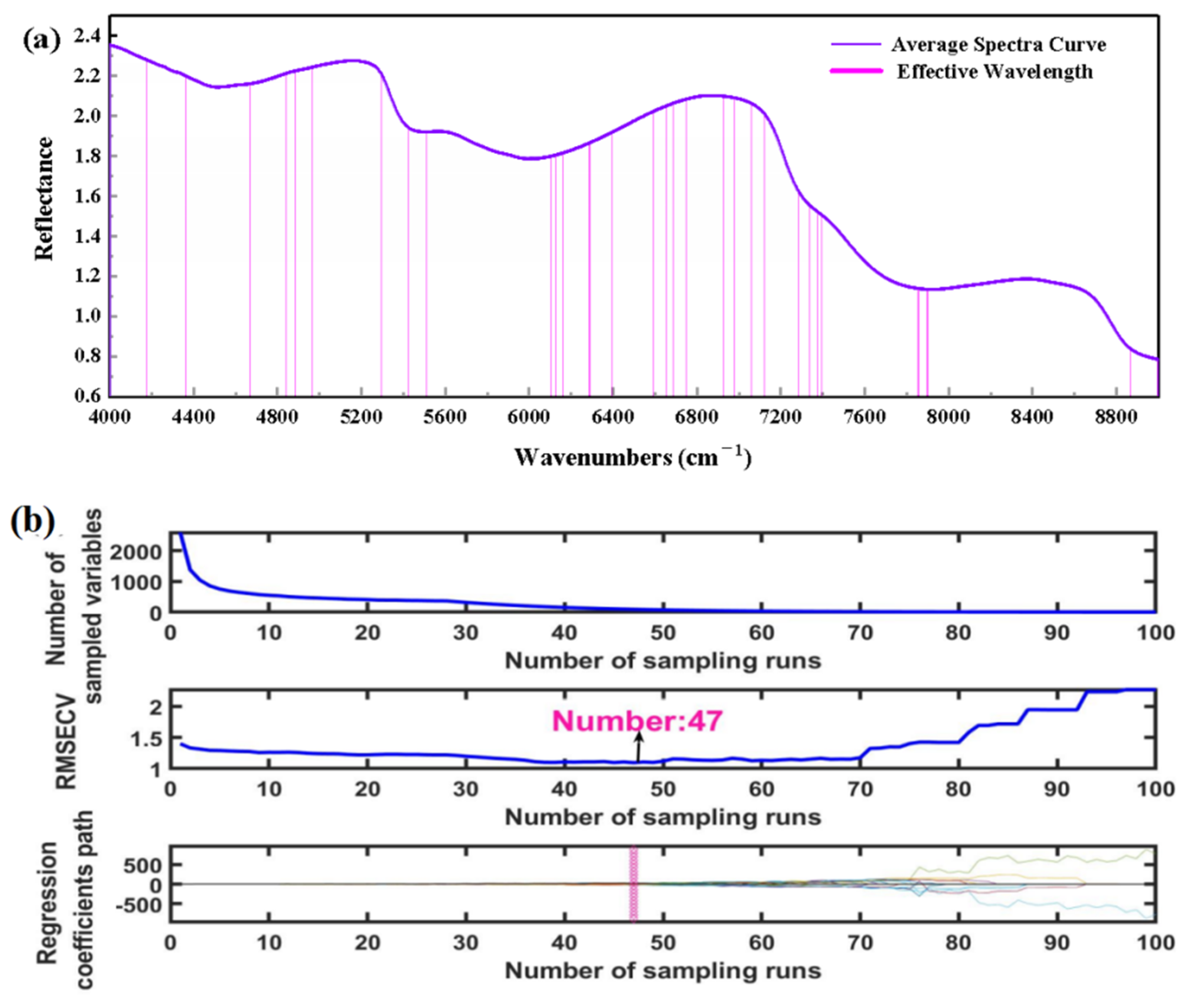
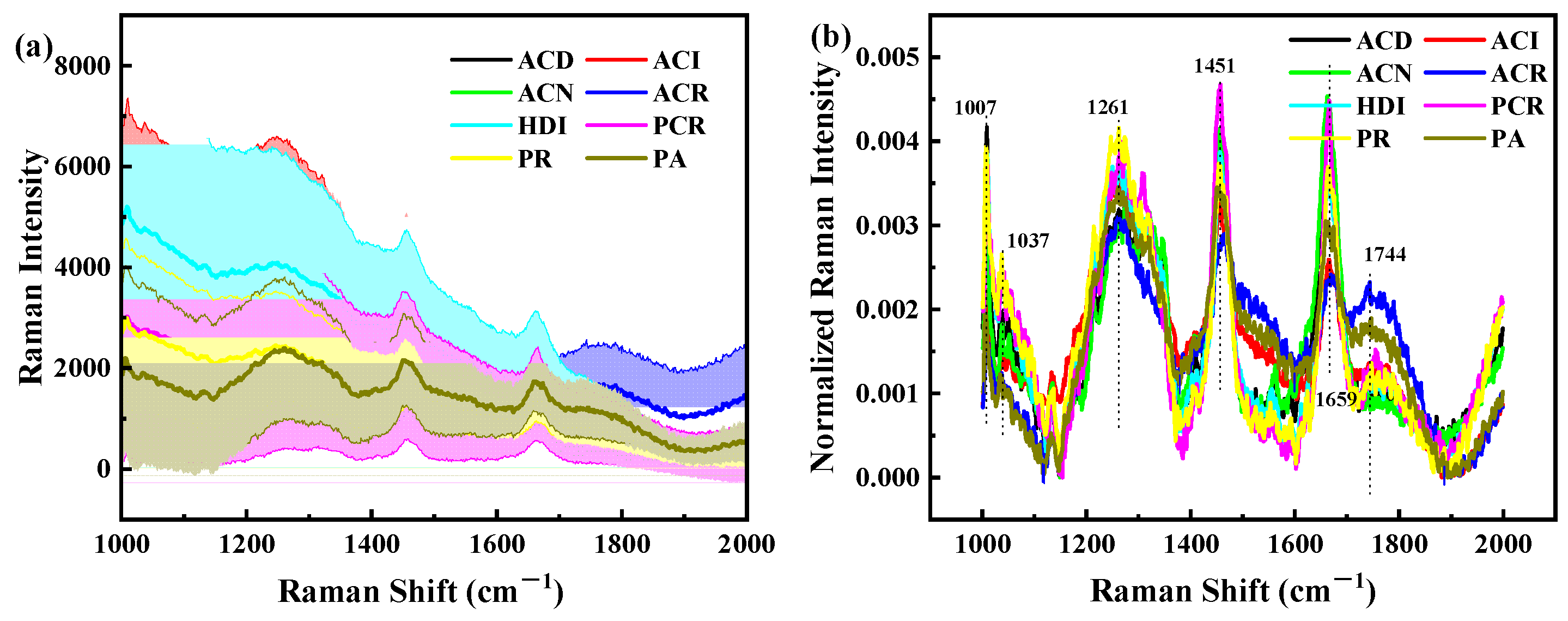
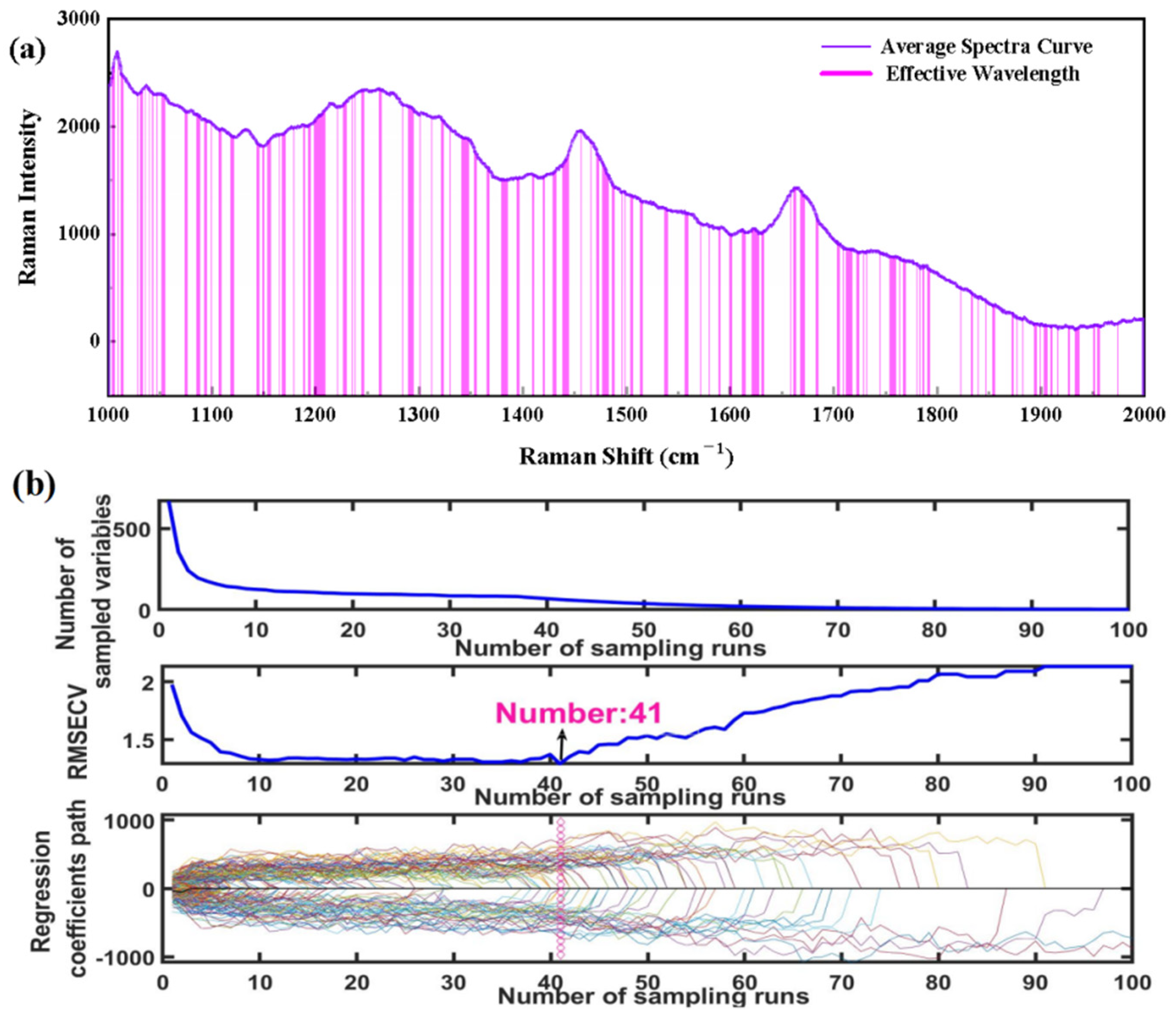
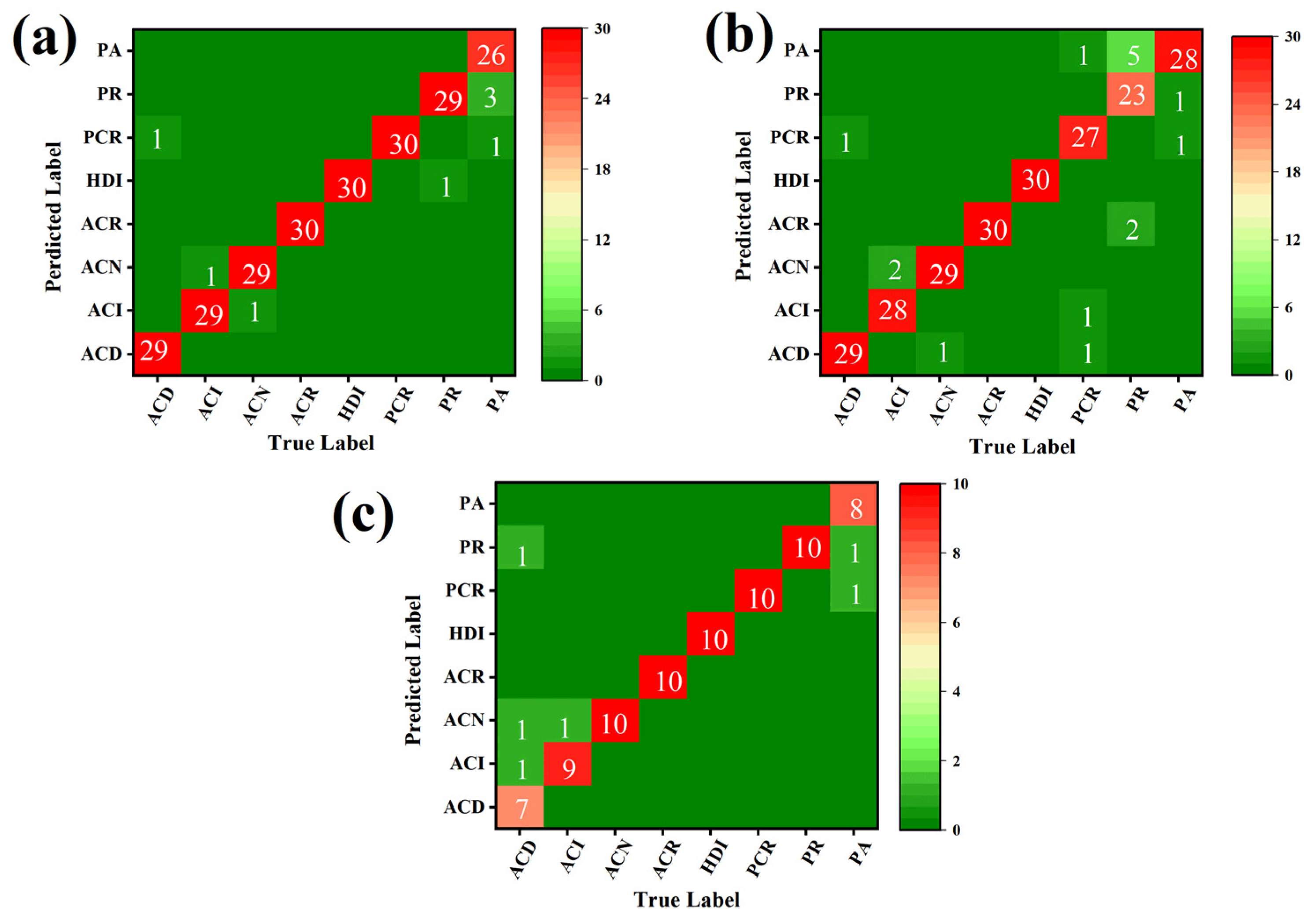
| Pretreatment Method | Number of Variables | LVs | Calibration Set | Cross-Validation Set | Prediction Set | ||||||
|---|---|---|---|---|---|---|---|---|---|---|---|
| SEC | SPC | ACC | SECV | SPCV | ACCV | SEP | SPP | ACP | |||
| NIR-None | 2593 | 6 | 86.26 | 85.88 | 86.07 | 85.00 | 85.54 | 85.27 | 85.00 | 85.38 | 85.18 |
| NIR-NOR | 2593 | 6 | 86.68 | 85.83 | 86.25 | 84.59 | 85.23 | 84.91 | 85.00 | 85.00 | 85.00 |
| NIR-MC | 2593 | 6 | 85.84 | 88.33 | 87.08 | 84.16 | 87.78 | 85.98 | 88.75 | 88.21 | 88.48 |
| NIR-MSC | 2593 | 7 | 87.51 | 89.23 | 88.36 | 87.10 | 88.91 | 88.01 | 83.75 | 88.21 | 85.98 |
| NIR-SNV | 2593 | 7 | 87.51 | 89.29 | 88.39 | 87.10 | 88.91 | 88.01 | 83.75 | 88.21 | 85.98 |
| NIR-FD | 2593 | 6 | 90.81 | 85.88 | 88.36 | 74.18 | 86.83 | 80.51 | 68.75 | 85.88 | 77.32 |
| NIR-BA | 2593 | 5 | 87.19 | 85.25 | 84.55 | 85.20 | 85.60 | 83.15 | 84.53 | 84.96 | 83.66 |
| NIR-SNV with MC | 2593 | 7 | 89.81 | 92.19 | 89.64 | 89.34 | 91.57 | 89.08 | 89.53 | 90.84 | 87.95 |
| Raman-None | 669 | 5 | 78.39 | 73.44 | 76.99 | 72.74 | 72.94 | 74.23 | 66.25 | 74.57 | 71.79 |
| Raman-NOR | 669 | 7 | 82.13 | 86.49 | 85.00 | 73.17 | 86.16 | 81.13 | 60.47 | 87.61 | 75.80 |
| Raman-SG | 669 | 8 | 80.40 | 85.30 | 82.86 | 75.00 | 84.34 | 79.67 | 68.75 | 83.58 | 76.16 |
| Raman-SNV | 669 | 7 | 77.93 | 82.98 | 80.45 | 67.93 | 82.26 | 75.09 | 53.75 | 81.43 | 67.59 |
| Raman-BA | 669 | 6 | 83.50 | 84.70 | 83.01 | 77.77 | 84.44 | 79.97 | 68.91 | 84.85 | 76.43 |
| Raman-SNV with NOR | 669 | 7 | 75.58 | 86.02 | 80.45 | 64.33 | 85.22 | 75.09 | 47.97 | 84.64 | 67.59 |
| Raman-BA with NOR | 669 | 6 | 88.76 | 87.19 | 87.98 | 78.33 | 88.03 | 83.18 | 76.25 | 89.10 | 82.68 |
| Raman-SG with NOR | 669 | 6 | 77.51 | 82.09 | 79.79 | 74.99 | 81.29 | 78.15 | 60.00 | 83.40 | 71.70 |
| Modelling Profile | Variable Amounts | LVs | Calibration Set | Cross-Validation Set | Prediction Set | ||||||
|---|---|---|---|---|---|---|---|---|---|---|---|
| SEC | SPC | ACC | SECV | SPCV | ACCV | SEP | SPP | ACP | |||
| SNV-MC-CARS-NIRS | 93 | 13 | 95.85 | 97.24 | 96.55 | 91.68 | 96.08 | 93.87 | 83.75 | 96.55 | 89.64 |
| SNV-MC-IRIV-NIRS | 83 | 17 | 98.34 | 97.96 | 98.15 | 91.26 | 96.3 | 93.78 | 85.00 | 96.25 | 90.63 |
| SNV-MC-SPA-NIRS | 9 | 7 | 84.20 | 89.25 | 86.34 | 89.35 | 89.10 | 86.01 | 86.88 | 87.90 | 86.25 |
| BA-NOR-CARS-RS | 64 | 8 | 88.75 | 88.68 | 88.72 | 73.35 | 87.55 | 80.45 | 65.00 | 86.78 | 75.89 |
| BA-NOR-IRIV-RS | 134 | 8 | 88.29 | 91.36 | 90.42 | 76.40 | 91.10 | 84.35 | 65.78 | 89.41 | 77.86 |
| BA-NOR-SPA-RS | 9 | 9 | 81.03 | 82.45 | 81.43 | 74.10 | 80.13 | 76.94 | 60.16 | 80.10 | 70.27 |
| Data Fusion Mode | Calibration Set | Cross-Validation Set | Prediction Set | ||||||
|---|---|---|---|---|---|---|---|---|---|
| SEC | SPC | ACC | SECV | SPCV | ACCV | SEP | SPP | ACP | |
| Bayesian information fusion | 96.67 | 99.40 | 99.06 | 93.33 | 99.05 | 98.33 | 92.50 | 98.93 | 98.12 |
| Feature layer fusion | 98.76 | 98.44 | 98.60 | 93.78 | 97.13 | 95.45 | 81.25 | 96.59 | 88.93 |
| Data layer fusion | 98.76 | 98.20 | 98.48 | 92.51 | 97.28 | 94.88 | 85.00 | 96.79 | 90.89 |
Publisher’s Note: MDPI stays neutral with regard to jurisdictional claims in published maps and institutional affiliations. |
© 2022 by the authors. Licensee MDPI, Basel, Switzerland. This article is an open access article distributed under the terms and conditions of the Creative Commons Attribution (CC BY) license (https://creativecommons.org/licenses/by/4.0/).
Share and Cite
Xu, Y.; Koidis, A.; Tian, X.; Xu, S.; Xu, X.; Wei, X.; Jiang, A.; Lei, H. Bayesian Fusion Model Enhanced Codfish Classification Using Near Infrared and Raman Spectrum. Foods 2022, 11, 4100. https://doi.org/10.3390/foods11244100
Xu Y, Koidis A, Tian X, Xu S, Xu X, Wei X, Jiang A, Lei H. Bayesian Fusion Model Enhanced Codfish Classification Using Near Infrared and Raman Spectrum. Foods. 2022; 11(24):4100. https://doi.org/10.3390/foods11244100
Chicago/Turabian StyleXu, Yi, Anastasios Koidis, Xingguo Tian, Sai Xu, Xiaoyan Xu, Xiaoqun Wei, Aimin Jiang, and Hongtao Lei. 2022. "Bayesian Fusion Model Enhanced Codfish Classification Using Near Infrared and Raman Spectrum" Foods 11, no. 24: 4100. https://doi.org/10.3390/foods11244100








